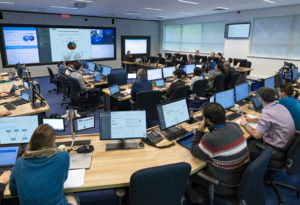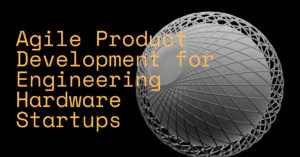An Overview of Agile Hardware Product Development
Agile development approaches have grown in popularity recently and for a good cause. They provide a flexible, adaptive framework for managing the product development process and are especially well-suited to a startup’s fast-paced, unpredictable environment.
We’ll look at Agile hardware product development techniques for startups and how Agile concepts may be applied to the particular problems of hardware development in this post.
One of the primary advantages of Agile development is its emphasis on iteration.
Instead of attempting to design and execute a complete project at once, Agile teams work in short, targeted sprints to provide a minimum viable product (MVP) as rapidly as feasible.
This enables teams to test and confirm assumptions early on and make changes as needed.
While Agile is extensively used in software development, its applicability to hardware creation is still in its early stages. Hardware development is intrinsically more complex than software development, and startups, in particular, may need several problems, including limited resources and experience and the need to fulfil strict regulatory criteria.
Despite these obstacles, many businesses are discovering that Agile concepts may be successfully adopted and used in hardware development.
Startups may improve their chances of generating a successful product by breaking down the product development process into digestible pieces, prioritizing and controlling the flow of work, and establishing a culture of cooperation and communication.
Tips for Engineering Startups looking to adopt an Agile Product Development Process
As a hardware startup, your company is in a great place to adopt an agile methodology and completely overhaul any processes that you might have already implemented.
Being a young organization gives you the flexibility to trial different development methodologies without the need to painfully retrain staff to think about these new processes.
By following agile principles, your engineering startup will be able to have an iterative approach to product development, which may give an advantage over your competitors.
Here’s some tips on how to get started building hardware within an agile product development methodology:
- Clearly define and prioritize your product backlog. This will ensure that your team is always working on the most important features and that everyone is aligned on the overall vision for the product.
- Establish regular sprints and hold daily stand-up meetings to ensure that everyone is on the same page and that any blockers are identified and addressed quickly.
- Encourage collaboration and open communication between team members. Agile is all about flexibility and adaptability, and this can only be achieved through effective communication and teamwork.
- Embrace a culture of experimentation and learning. Agile is all about iterating quickly and learning from your mistakes, so be open to trying new things and be prepared to pivot if something isn’t working.
- Make sure to track progress and measure success using metrics that are meaningful to your team and stakeholders. This will help you identify areas for improvement and ensure that you are making progress towards your goals.
- Finally, make sure to celebrate wins and successes along the way. Agile can be challenging, and it’s important to acknowledge and celebrate the progress that you are making.

How to Hire and Onboard Engineers in a startup: An Agile Approach with Scrum
How long do you think is the appropriate amount of time to onboard your new team of engineers in order to get them on board with your company’s mission and the way of working?
1 week? Maybe 2?
Perhaps a whole month?
Well, according to perhaps the world’s most successful and agile hardware startup, SpaceX, the ideal onboarding should take no longer than 4 hours!
Watch SpaceX’s agile program manager, Joe Justice, talk about why they do this, as well as a brief explanation of their anti-handbook handbook that is given to new employees.
You can also watch Joe’s full talk at the engineering conference Iteration22 where he discussed how the company managed to move so fast and be the world’s (and for all we know, the universe’s) leading manufacturer of rockets.
Managing Complexity in Hardware Development Strategies
One of the most challenging aspects of hardware development is dealing with complexity. Unlike software, hardware products may need the integration of various components, subsystems, and even different technologies.
This makes designing and executing an efficient and productive development process challenging.
One method for dealing with complexity is to divide the product into smaller, more manageable portions.
This may be accomplished by developing a system model that depicts the interactions between various components and subsystems and specifying unambiguous interfaces between them. This method enables teams to focus on smaller, more achievable tasks while making it easy to assess progress and spot possible concerns.
Prioritizing and controlling the flow of work is another important method for dealing with complexity. This is done by using methods such as Scrum or Kanban, which give a framework for organizing and prioritizing activities.
Teams may make the most of their limited resources and skills by first focusing on the most critical activities.
Finally, seeking ways to eliminate waste and enhance efficiency is critical.
This may be accomplished through prototyping and simulation tools to test and confirm assumptions early on, as well as through Agile methods such as pair programming and continuous integration to promote cooperation and communication within the development team.
Agile Hardware Development Collaboration and Communication
Collaboration and communication are critical to the success of any Agile development project, particularly in hardware development.
With various teams and stakeholders engaged, developing efficient communication channels and explicit knowledge of roles and responsibilities is crucial.
Creating cross-functional teams is one of the finest strategies for improving cooperation and communication. This entails assembling individuals with diverse talents and experience, such as engineers, designers, and product managers, to collaborate on a single purpose.
Cross-functional teams can assist in enhancing productivity and improving product quality by breaking down silos and establishing a feeling of shared responsibility.
Another critical part of cooperation and communication is the usage of technologies and platforms that aid communication and keep stakeholders informed and involved.
Platforms like Valispace, for example, may be used to store and share drawings and specs, making it simple for team members to work on designs and specifications. This can assist in ensuring that everyone is on the same page and aid in the early detection of faults and discrepancies.
Requirements Management in Agile Hardware Development
Managing needs is essential for every product development project, but it is necessary for hardware development. With so many distinct components and subsystems to consider, it’s critical to understand what’s needed and to be able to link requirements to design and testing processes.
A requirements management application, such as Valispace, Jira or IBM DOORS, is one method for collecting and maintaining requirements.
These technologies enable teams to establish and manage requirements in one place, making it simple to keep track of what needs to be done and discover any difficulties or discrepancies.
Another critical feature of requirement management is tracking requirements back to design and testing operations. This may be accomplished by developing a traceability matrix that depicts the connections between requirements and other processes like design, testing, and validation.
Teams may guarantee that they satisfy all relevant criteria and that the product is suitable by establishing a clear relationship between requirements and other activities.
It’s also critical to have a strategy to deal with requirement modifications. This may be accomplished by developing a change control process that specifies the procedures for requesting, authorizing, and implementing changes.
By implementing a defined methodology, teams may guarantee that modifications are controlled and consistent and do not negatively affect the development process.
System Model Management in Agile Hardware Development
Another critical component of hardware development that might be particularly difficult in an Agile context is managing system models. With so many components and subsystems to consider, it’s critical to have a firm grasp on how everything fits together and the ability to integrate system models with requirements and design activities.
System modelling tools like MagicDraw or SysML can create and manage system models. These technologies enable teams to develop detailed system models, including components, interfaces, and interactions.
This can assist in ensuring that everyone understands how everything fits together and can aid in the identification of any possible faults or discrepancies.
Another critical feature of system model management is the capacity to link them with requirements and design activities.
This may be accomplished by employing a technology such as Valispace, which can store and distribute system models and relate them to requirements and design processes. Teams may guarantee that they fulfil all relevant requirements and that the product is suitable by establishing a clear relationship between system models and other activities.
Valispace’s Agile Hardware Development
Valispace is a cloud-based solution for supporting Agile hardware development.
It enables teams to save and share designs, requirements, and system models and link them in real time. This can assist in ensuring that everyone is on the same page and aid in the early detection of faults and discrepancies.
For most hardware engineering projects that want to go agile, the most helpful unique feature relates to the ability to connect requirements to engineering data.
This feature allows teams to ensure that all requirements are linked to engineering values and that any numerical data can be read and analyzed as such, rather than as flat text data.
This means that if any changes are made to your system, Valispace can automatically calculate whether this violates any of your project requirements.
Less work for your engineers, smarter insights for your project managers, and happier customer that love your product.
Another critical aspect of Valispace is its support for various agile development techniques such as Scrum and Kanban. This implies that teams may select the method that best meets their needs and adapt and adjust as necessary.
Valispace also offers a variety of additional features and tools that can aid with Agile hardware development including:
- Version control
- Communication tools
- Reporting and analytics.
Valispace can assist teams in managing complexity, collaborating efficiently, and delivering a great product by providing a comprehensive collection of tools and functionalities.
If you’re interested in adopting Valispace for your Agile hardware development project, schedule a call with the Valispace team to discuss your unique requirements and determine appropriateness. The unit can also assist you in implementing and customizing the platform to match your needs.


